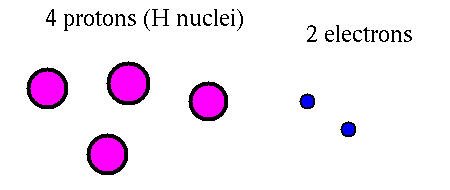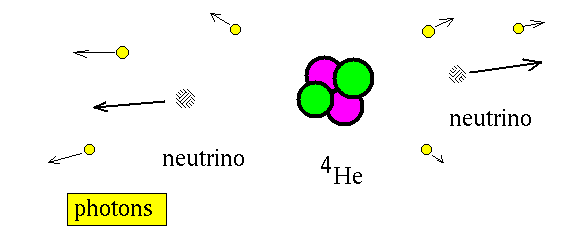Where does the energy output of the Sun come from?

Matter is made of atoms

The Sun is made of atoms too. Mostly they are ionized, so we should
think of the Sun as being made of nuclei and electrons. But what kind
of nuclei?
We can find out by analyzing sunlight, as we will see shortly.
The result
- About 75% (by mass) H.
- About 25% (by mass) He.
- A small amount of heavier elements.
The
middle of the Sun
is a very hot gas. It is ionized: all of the
electrons have been ripped away from the nuclei because it is so
hot. The nuclei available are mostly 1H, quite a lot
of 4He, and a few 2H and 3He. (There
are a few other types, but they are not so important for us.)
What is happening in the middle of the Sun is analogous to burning
methane:
C H4 + 2 O2 --> C O2 + 2 H2 O
In this reaction, the final molecules have less internal energy
than the starting molecules. Since energy is conserved, the extra energy
is released as energy of motion of the molecules. That is the gas gets
hotter. The amount of energy involved is 5.5 eV each time
the reaction above happens.
As we have seen, much more energy than that must be involved in the
reactions inside the Sun and other stars. The evidence is strong
that the overall reaction is "burning" hydrogen to make helium:
4 1H + 2 e --> 4He + 2 neutrinos + 6 photons
The high energy photons produced by the nuclear process don't get far. They
are absorbed and heat the gas. The helium remains in the middle of the Sun.
The neutrinos easily zip out of the Sun. (Neutrinos easily zip through
most anything, reacting with matter only rarely.)


In this reaction, the final particles have less internal energy than
the starting particles. Since energy is conserved, the extra energy is
released as energy of motion of the nuclei and electrons in the solar
gas, the production of lots of low energy photons and, finally, the
energy of the neutrinos, which just zip right out of the Sun. That is
the gas gets hotter and has lots of photons (and neutrinos). The amount
of energy involved is 26 MeV = 26 x 106 eV each time the
reaction above happens.
Why do we think that this is what goes on?
- Energy output of millions of eV per reaction is needed if the Sun
has been producing energy at the observed rate over billions of years.
- The reactions exist. (They have been studied in the laboratory.)
- There is a consistent step-by-step theory for the reaction.
The reaction as given above is a summary. Really the reaction occurs in
several steps.
The Sun is typical of stars. The evidence indicates that this happens
in the middle of all stars, giving them the energy to make starlight.
Davison E. Soper, Institute of Theoretical Science,
University of Oregon, Eugene OR 97403 USA
soper@bovine.uoregon.edu




